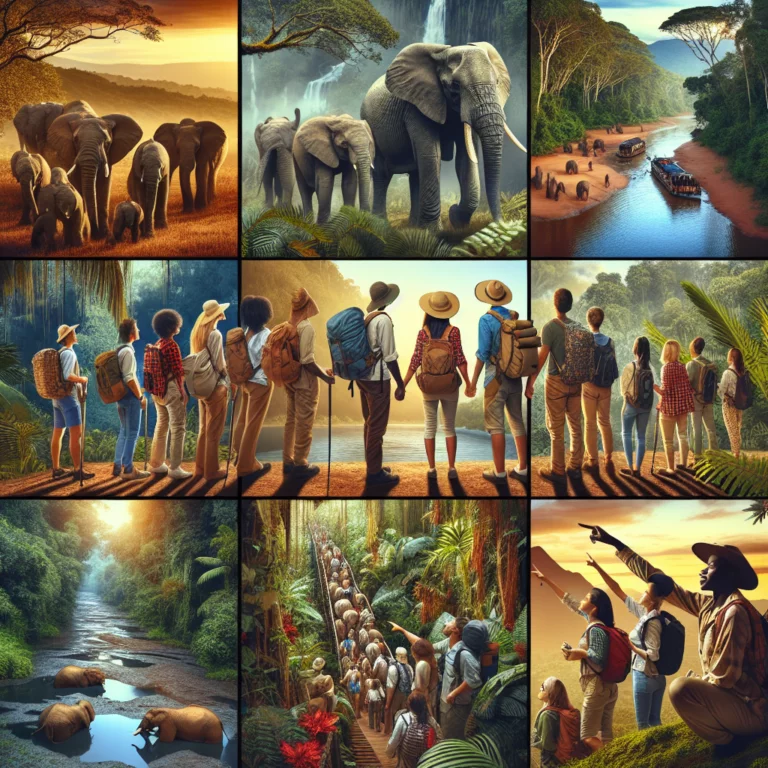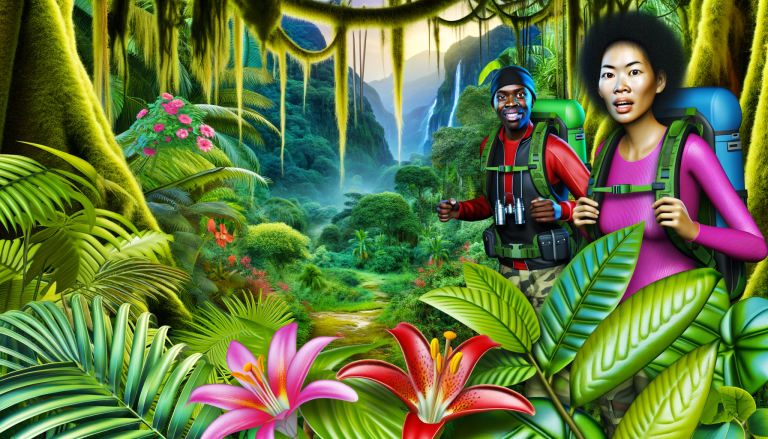Diving Into the Wilderness: Unraveling Jungle Safaris in India
Exploring India’s Wildlife Diversity
Going on a jungle safari in India is like stepping into a world where nature puts on its most dazzling show. India’s wild areas are buzzing with life, and you’re in for a real treat if you decide to explore them. Put on your explorer hat, and let’s dive into the rich wildlife that makes this country a top pick for nature enthusiasts.
Rich Biodiversity of Indian National Parks
Wandering through India’s national parks is like flipping through nature’s scrapbook—each page filled with unique critters and breathtaking views. Here’s a quick tour:
- Jim Corbett National Park: This one’s the old timer of the bunch, being India’s very first national park. Named after hunter turned wildlife protector Jim Corbett, it sprawls over 520.8 square kilometers in the lower Himalayas. Think of it as the Broadway of the animal kingdom, with stars like leopards, elephants, and those funny langur monkeys taking the stage (Lonely Planet).
- Kaziranga National Park: If one-horned rhinos were rockstars, they’d be booking shows here. Kaziranga houses two-thirds of the planet’s gang of these tough-skinned heavyweights. Their numbers have climbed from a mere 12 back in 1908 to an impressive 1,855 today. They’re the headline act year-round (Natural World Safaris).
Unique Wildlife Species in India
India doesn’t just flaunt its cultural kaleidoscope but also its fabulous array of wildlife. Here’s a peek at what you might witness on your safari escapade:
- Tigers: India’s proudly holding onto 70% of the world’s tiger troop. These majestic big cats roam freely in many parks, luring tourists with dreams of catching a glimpse (Lonely Planet).
- Asiatic Elephants: You’ll find 60% of these massive but mellow behemoths lounging around India’s protected lands.
- Bird Species: For the feathered-friend fans, join an avian carnival with over 1,360 bird species from the splashy Indian Peafowl to the more reclusive Great Indian Bustard.
- Reptiles and Mammals: With 600 reptile species and 400 types of mammals, India could make any herpetologist or mammalologist grin. The snow leopard, the high-altitude ghost, teases viewers in Hemis National Park around March and April (Natural World Safaris).
| Animal | Population in India | Best Location | Best Time to See |
|---|---|---|---|
| Bengal Tiger | 70% of global population | Multiple national parks | Year-round |
| Asian Elephant | 60% of global population | Various national parks | Year-round |
| One-Horned Rhino | 1,855 individuals | Kaziranga National Park | Year-round |
| Asiatic Leopard | 12,000 – 14,000 | Jawai | October to March |
| Snow Leopard | Rare | Hemis National Park | March-April |
India’s wild havens are more than just eye candy—they’re essential parts of the Earth’s natural beauty. As you gear up for your wild walkabout, cherish these bastions of biodiversity; they’re here for us and the generations yet to wander.
Top National Parks for Jungle Safaris
Jim Corbett National Park
Oh, Jim Corbett National Park! The granddaddy of Indian parks, sitting pretty in the Himalayan foothills. Stretching over 520 km², this place is named after a cool guy, Jim Corbett, who traded in his hunting rifle for a conservation badge. What will you find here? Leopards having lazy siestas, elephants strutting their stuff, sloth bears with their awkward charm, spotted deer playing hard to get, cheeky langur monkeys, and those toothy gharials pretending to be innocuous floaties in water.
| Wildlife | Best Time to Visit |
|---|---|
| Leopards | April to June |
| Elephants | November to June |
| Sloth Bears | March to May |
| Spotted Deer | All year |
| Langur Monkeys | All year |
| Gharials | October to May |
Kaziranga Wildlife Park
Kaziranga, the superstar of Assam, hugs a massive 430 km² and is showing off with its posse of one-horned rhinoceroses. Yep, over two-thirds of these jazzy creatures hang out here. Whether it’s ducks doing a funky dance or tigers making cameo appearances, Kaziranga’s got it covered. There’re wild elephants, water buffalos striking a pose, swamp deers nervously flicking their tails, leopards slinking through the underbrush, and enough birds to start an orchestra.
| Wildlife | Best Time to Visit |
|---|---|
| One-Horned Rhinoceroses | November to April |
| Wild Elephants | November to April |
| Water Buffalos | November to April |
| Swamp Deer | November to April |
| Tigers | November to April |
| Leopards | November to April |
| Birds | November to April |
Kanha National Park
Now Kanha National Park in Madhya Pradesh, this one feels like flipping through the pages of “The Jungle Book.” With 940 km² of adventure, it’s a living kaleidoscope of creatures like langurs moving like acrobats, sloth bears rambling, leopards-a-lurking, and wild dogs debating whether to howl or bark. Fancy a ride? There are rugged 4WD safaris waiting for you, or stroll with a guide who knows the lay of the land as well as the back of their hand.
| Wildlife | Best Time to Visit |
|---|---|
| Langurs | All year |
| Sloth Bears | April to June |
| Leopards | April to June |
| Wild Dogs | April to June |
| Deer | All year |
Ranthambore National Park
Ah, Ranthambore! Picture 1334 km² of Rajasthan peppered with trees and grassy patches, setting up the perfect stage to meet tigers, leopards, and water buffalos getting up to no good. Wild boars and hyenas sweeten the pot, while langurs and wild dogs add to the antics, and deer make it a full house. But wait, there’s more. Peek into ancient temples, havelis, and soak in the stories held by old water tanks.
| Wildlife | Best Time to Visit |
|---|---|
| Tigers | October to May |
| Leopards | October to May |
| Water Buffalo | October to May |
| Wild Boars | October to May |
| Striped Hyenas | October to May |
| Langurs | All year |
| Wild Dogs | October to May |
| Deer | All year |
For the full Ranthambore experience, hop on a Jeep or catch a Canter Safari — the likes of which are divided into ten zones with morning and afternoon expeditions. Pro tip: Book ahead if you’re feeling supersonic and want the smoothest ride!
Central India’s Wildlife Spectacle
Wildlife Diversity in Central India
Central India is a dream for anyone wild about wildlife. Picture lush landscapes buzzing with life and beasties that have starring roles around the campfire. Yep, I’m talking about the Royal Bengal Tiger, Gaur, Wild Dog, Bara Singha, Sloth Bear, and Leopard. Trust me, these guys are like rockstars in the animal kingdom. Chuck in a bunch of colorful birds, and you have yourself one hot spot for jungle safaris.
| Animal Crew | Why They’re Awesome |
|---|---|
| Royal Bengal Tiger | King of the jungle (no crown needed). |
| Gaur | Big ol’ bison that’s all kinds of mighty. |
| Wild Dog (Dhole) | Packs a punch with team hunting skills. |
| Bara Singha | Swamp deer, but make it fancy. |
| Sloth Bear | Nighttime wanderer with a messy hairdo. |
| Leopard | Stealthy cat that blends in like a pro. |
Noteworthy Wildlife Parks in Central India
Central India’s got some killer national parks that are just the ticket for a life-sized game of “spot the beastie.” Each one is a treasure chest of plants and animals that’ll leave you grinning like a Cheshire cat.
Bandhavgarh National Park
If you’re on the prowl for tigers, Bandhavgarh is where you need to be. This place has more of them than you’d think possible. It’s not just tigers, though– you’ll find other predators, plant-munchers, and feathered friends strutting their stuff all over.
Kanha National Park
Kanha National Park is your golden ticket to relive “The Jungle Book” vibes. Imagine 940 square kilometers of wilderness packed with langurs, sloth bears, leopards, wild dogs, and oh-so-many deer.
| Spot | Superstar | Size (sq km) |
|---|---|---|
| Bandhavgarh | Royal Bengal Tiger | 1,536 |
| Kanha | Leopard, Wild Dogs, Sloth Bear | 940 |
Satpura National Park
Satpura is a hidden gem. Leopards, wild dogs, sloth bears, sambars—you name it, this park’s got it. Plus, its gnarly terrain and thick forests are basically an adventure waiting to happen.
Pench National Park
Remember “The Jungle Book”? Pench is its backyard. With tigers, leopards, and flashy birds, this park is like a live-action documentary. It’s a definite must-see for any all-nature-loving folks out there.
Tadoba Andhari National Park
Welcome to Tadoba Andhari, where you’ll be practically tripping over tigers. Throw in leopards, sloth bears, and a whole host of feathered critters, and you’ve got a park that screams “adventure.”
| Park | Critters Galore | Cool Points |
|---|---|---|
| Satpura | Leopards, Wild Dogs, Sloth Bears | Wild trails, thick bush. |
| Pench | Tigers, Fancy Birds | Real-life “Jungle Book.” |
| Tadoba Andhari | Tigers, Leopards, Bears | Tiger central, wildlife galore. |
Central India’s national parks aren’t just places to see critters—they’re places where awe and wonder grow on trees. From Satpura’s rugged wilds to Bandhavgarh’s tiger bonanza, each park is a story of its own, waiting for you to be its hero.
Best Times for Wildlife Sightings
If you’re itching to dive into India’s wild side and witness its magnificent creatures, you gotta know when to go. Whether you’re after the regal tiger or some other wild beast, timing is your best buddy to make the most of your jungle adventure.
Ideal Seasons for Tiger Spotting
Chasing tigers in India is something you’ll never forget. Trust me. Kanha National Park is where the magic happens, with its scenic mix of grassy fields and babbling brooks. The prime time to catch a glimpse of these sneaky striped felines is between March and April. That’s when the heat nudges them toward waterholes, making them easier to spot (Natural World Safaris).
| National Park | Best Months | Cool Stuff Here |
|---|---|---|
| Kanha National Park | March-April | Grasslands, streams |
| Ranthambore National Park | November-March | Historical ruins, diverse critters |
| Jim Corbett National Park | February-May | Thick forests, rivers |
Best Time for Spotting Other Critters
India’s got a colorful cast of critters, and they each have their own curtain call. Here’s the scoop for catching some of the star acts:
- Snow Leopards: March-April is your ticket. These elusive big cats trek down from their chill hideouts in hunt of food, and Hemis National Park in Ladakh is the spot to be (Natural World Safaris).
| Animal | Prime Time | National Park |
|---|---|---|
| Tigers | March-April | Kanha National Park |
| Snow Leopards | March-April | Hemis National Park |
| Asian Elephants | October-February | Kaziranga Wildlife Park |
| One-Horned Rhino | November-April | Kaziranga Wildlife Park |
Plan it right, and you’ll have stories to brag about for a lifetime. Remember to stick to park rules, dress like you’re in the jungle, and pick shoes that won’t trip you up on bumpy paths (Forsyth Lodge).
Planning and Booking Jungle Safaris
Safari Options in Ranthambore National Park
Alright, let’s chat about your wild adventure options in Ranthambore National Park. When you’re looking to dive into the wild, you’ve got two sweet rides to choose from: the Jeep Safari and the Canter Safari.
- Jeep Safari: Picture this as your VIP ticket to nature. With room for 6 folks, it’s all about that up-close-and-personal wildlife moment. Its sleek size slips you into those hidden trails where bigger vehicles just can’t squeeze in.
- Canter Safari: Roll call for the party bus of safaris! If you’ve got a bigger crew (up to 20 people, to be exact), this is your jam. Sure, it’s not as cozy as the Jeep, but you’ll cover more ground and it won’t burn a hole in your wallet as much.
These tours book up faster than you can say “tiger,” so make sure you snag your ride ahead of time. They kick off in the crack of dawn at 6:30 am until 10:00 am, or you can catch the sunset vibes from 2:30 pm to 6:00 pm. (Ranthambore National Park)
Booking Procedures and Zone Selection
Booking a jungle safari in Ranthambore ain’t rocket science, but you do need to be a lil’ ahead of the game. Here’s your cheat sheet:
Online Booking: Go digital, folks! Hop onto the Ranthambore National Park’s website and book your safari. Do it early, especially when everyone’s buzzing about it during peak seasons.
Selecting Safari Type: Decide your flavor—Normal Safari is your regular outing, but if you’re looking for those last-minute thrills with some extra bling, Tatkal or VIP Safari’s your pick (Ranthambore National Park).
Choosing Safari Zone: The park’s sliced into 10 distinct flavor zones. If you’re chasing tiger tales, Zones 1 through 6 dish out the best stories. But each zone packs its own safari punch, so brush up before making that call.
| Safari Zone | Why It’s Cool |
|---|---|
| Zone 1 | High-octane tiger spotting, Noor’s kingdom |
| Zone 2 | Splash zones, all kinds of critters |
| Zone 3 | Padam Talao, where past meets present |
| Zone 4 | Lakeside vibes, T24’s backyard |
| Zone 5 | Forests thick as secrets, leopard legends |
| Zone 6 | Tree of Fateh, a birdwatcher’s paradise |
- Payment and Confirmation: Seal the deal with your payment, and voilà, you’ve got a golden ticket! Print that confirmation or snap a pic on your phone for easy access when you roll up on safari day.
Get your ducks in a row before you go, and you’ll be gliding through Ranthambore’s wilds stress-free. Whether it’s the Jeep hug or the Canter crew, brace for those heart-thumping moments where nature comes alive and winks at you!
Engaging Safely in Jungle Safari Activities
Essential Attire and Gear for Safaris
Getting ready for a jungle safari in India? Let’s talk about getting the attire and gear right for your comfort and safety. What you wear and carry can totally change your experience out there.
Dressing Tips:
- Weather-Based Clothing: Think about what the sky is doing and dress for it. Also, listen to the rules of the park.
- Easy-To-Move Clothing: Go for loose clothes that let you move like a ninja.
- Shades to Blend: Pick greens, browns, or beiges so you’re not playing peek-a-boo with the critters.
- Tough Shoes: Find some strong shoes that can fight uneven ground and long strolls.
- Sun Blockers: Pop on a wide-brimmed hat or cap to dodge those sunburns.
Must-Have Gear:
- Binoculars: Perfect for catching a glimpse of wildlife from afar.
- Camera: Snag a camera with primo zoom for snapping memories.
- Bug Off Spray: Keep those mosquitoes and bugs at bay.
- Hydration Buddy: Bring a trusty water bottle to stay refreshed.
Photography Etiquette and Safety Guidelines
Behaving like a respectful guest in the jungle keeps everyone safe and ensures a smooth ride during your safari adventure.
Photo Tips:
- Wildlife Focus: Let the animals hog the limelight in your snaps.
- Keep Your Distance: Stay back and watch them do their thing without a human audience.
- Ditch the Flashbang: Flash can freak out the critters—stick to the sunlight.
- Silence is Golden: Stay quiet to let nature do the talking.
Safety Reminders:
- Trash-Free Zone: Littering is a no-go; pack out what you bring in.
- Quiet Time: Keeping it down boosts your animal-spotting odds.
- Camp Rules: Follow the park’s dos and don’ts for a safe trip (shoutout to Forsyth Lodge).
| What’s Essential | Why You Need It |
|---|---|
| Easy clothes | Gives you smooth moves and comfort |
| Camo colors | Keeps you sneaky and cool around wildlife |
| Durable kicks | Keeps your feet happy on rough trails |
| Sun hat or cap | Keeps the sun off your face |
| Specs (Binoculars) | Helps you see creatures in the distance |
| Quality cam | Captures those unmissable safari moments |
| Bug spray | Shields you from pesky critters |
| H2O container | Keeps you hydrated and ready to explore |
If you want your jungle safari to be the stuff of legends, staying mindful of what you wear, pack, and how you act in the wilderness is key. Follow these easy guidelines, and you’ll enjoy an unforgettable adventure, basking in India’s amazing biodiversity.







